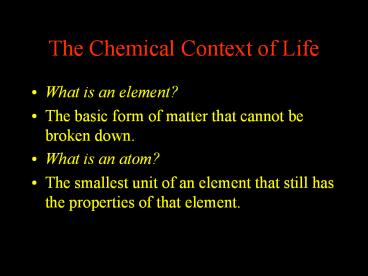The Chemical Context of Life - PowerPoint PPT Presentation
1 / 14
Title:
The Chemical Context of Life
Description:
The Chemical Context of Life What is an element? ... Chemical Bonds: Covalent bond: results from sharing a pair of electrons polar covalent bond: ... – PowerPoint PPT presentation
Number of Views:170
Avg rating:3.0/5.0
Title: The Chemical Context of Life
1
The Chemical Context of Life
- What is an element?
- The basic form of matter that cannot be broken
down. - What is an atom?
- The smallest unit of an element that still has
the properties of that element.
2
What are the subatomic particles?
- Neutrons, which have no charge
- protons, which have a positive charge
- electrons which have a negative charge.
3
Characteristics of elements
Number of protons in the nucleus of the atom
- Atomic number
Number of protons number of neutrons in the
nucleus.
- Atomic mass number
An element that has a different atomic mass than
normal due to a change in the normal number of
neutrons
- Isotope
4
Electrons
- Located outside of the nucleus
- Unless otherwise indicated the number of
electrons is the same as the number of protons. - Potential energy of electrons increases as their
distance from the nucleus increases. - Electrons orbit the nucleus in energy levels.
5
Electron Energy Levels
6
Electron energy levels
2
- The 1st energy level contains how many electrons?
8
- The 2nd energy level contains how many
electrons?
8
- The 3rd energy level contains how many
electrons?
- An element whose valence shell is complete is
said to be ________________________.
inert or unreactive
7
Electron Orbitals
8
Electron Configurations of First 18 Elements
9
Chemical Bonds
- Covalent bond
results from sharing a pair of electrons
- nonpolar covalent bond
equal sharing
- polar covalent bond
unequal sharing
10
What sort of covalent bonds are seen here?
11
Nonpolar Covalent bonds
Polar covalent bonds
12
Ionic Bonds
- Ion
transfer of electrons between atoms.
attraction between two oppositely charged ions
- Ionic bond
- cation
positively charged ion (lost electron)
- anion
negatively charged ion (gained electron)
13
Hydrogen Bonds
- Oxygen is one of the most electronegative
elements - In a water molecule electronegative oxygen hogs
electrons. - This hogging of electrons results in which type
of bond between oxygen and hydrogen within the
water molecule?
Polar covalent
14
- Hydrogen bonds occur between two polar molecules,
or between different polar regions of one large
macro-molecule. - One relatively negative region is attracted to
a second relatively positive region.































